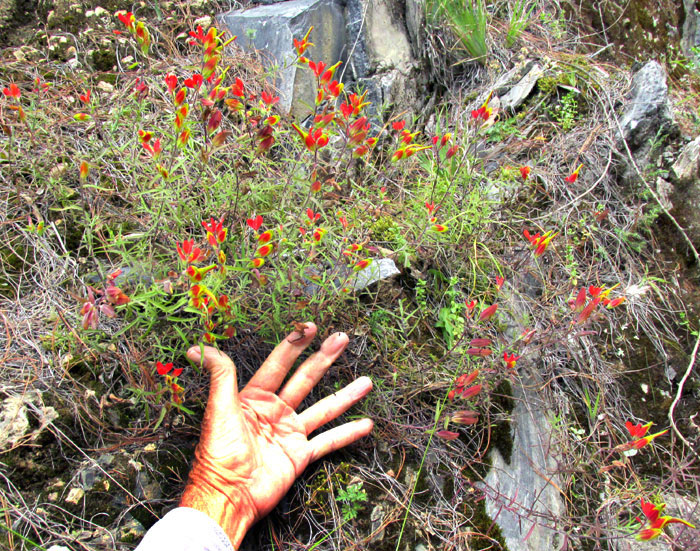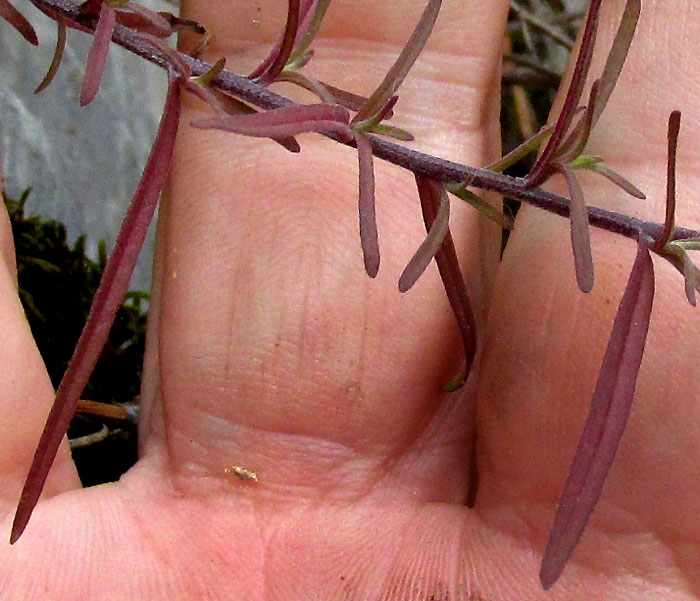Excerpts from Jim Conrad's
Naturalist Newsletter
entry from field notes dated January 19, 2023, taken in disturbed areas and along Hwy 120 on the north and east side of town, elevation ±2,380m (7600 ft); bedrock of Cretaceous limestone, in the Eastern Sierra Madre mountains; walking distance of Pinal de Amoles, Querétaro state, MÉXICO,(N21.137°, W99.622°)
CASTILLEJA INTEGRIFOLIA

On an old, south-facing roadcut beside Hwy 120, the above wildflower rooted in cracks in the limestone. Up close it was clear that here was yet another of the 200 or so species of the genus Castelleja, of which about 40 species are documented in Mexico. Up north members of the genus are called Indian Paintbrushes, though that name is shared with several other red-flowered plants.

Castelleja is recognized by its stem-top inflorescences composed of bilaterally symmetrical flowers shaped somewhat like lobelia blossoms, with each flower closely subtended by a conspicuous, modified leaf, or bract. Usually the flowers and bracts are red, often with either yellow or orange. In the above picture, the red and yellow bracts, with their two ridges, largely conceal the flowers.
In the above picture, the most important field marks for this species include: that some of the flowers arise from atop slender, unusually long stalks, or pedicels; stem, pedicels and bracts are densely short-hair; The top of the corolla is fuzzy, and; the flowers' combinations of red and yellow.

The leaves are exceptionally narrow. To distinguish this species from closely related and similar ones, it's important to notice that leaf bases gradually diminish in width to their point of attachment, where the blade margins appear to descend onto the stem to form a low ridge -- the bases are "decurrent."
The narrow leaves and large bracts lead us to a similar-looking cluster of species known as the Castilleja tenuiflora complex. Fortunately, there's a 1992 publication by Guy Nesom entitled "Taxonomy of the Castilleja tenuiflora Group (Scropulariaceae) in Mexico, with an overview of Sect. Castilleja." Distribution maps and descriptions in that work indicate that here we have CASTILLEJA INTEGRIFOLIA.
Castilleja integrifolia is distributed from northeastern Mexico south into Nicaragua, is absent in Costa Rica and Panamá, but reappears in Columbia. It's described as inhabiting oak-pine, pine and pine-fir forests at 1500-3650m (4900-12,000ft) elevation.
Nesom points out that historically there's been confusion between this species and the very similar Castilleja tenuiflora variety xylorrhiza. In the Flora del Valle de Tehuacán-Cuicatlán the author says that flowers of the latter species arise from pedicels no longer than 6mm, while the pedicels of integrifolia reach 20mm long, like those on our plant.
On the Internet I can't find flowers with the exact yellow/red combination our blossoms display. However, Nesom says that the species is variable, plus I read that certain Castilleja species readily hybridize, so variations are to be expected.
Castilleja species are semi-parasitic; they rob sap from roots of grasses and herbs, yet they also possess green chlorophyll for photosynthesizing their own food. In her 2016 doctoral dissertation, Natalie Schmidt's "Parasitic plants and community composition: how Castilleja levisecta affects, and is affected by, its community" described how a Castilleja species could affect species composition by stressing the plants they parasitized, making it harder for the parasitized plants to compete for resources.
On the other hand, Nate Haan and others in their 2021 "Preference, performance, and chemical defense in an endangered butterfly using novel and ancestral host plants," report that the leaf-eating larvae of certain insect species absorb compounds from Castilleja foliage they eat, and these compounds then make the larvae inedible to their predators.